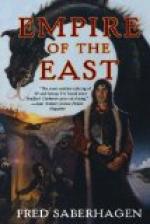The ring of men slowly danced their way from the Market Square to the Governor’s house, where more spirits were given, and an accordion player joined the ring.
Loud cries of “Zivio!” followed the cessation of every movement. We followed and went in to the Governor, to offer our congratulations and drink His Royal Highness’s health. The room was quite full, two or three men being rough peasants, relations of the Governor. There is very little class distinction in Montenegro. Often the humblest peasant can claim relationship with the Voivoda, or Duke, of the province, and will always be cordially received.
We felt quite ashamed of our appearance—leather coats, collarless shirts, and so forth—amongst such rich costumes. The complete outfit of a Montenegrin dandy costs over forty pounds, and takes a bit of beating.
Carefully tucking our rough riding-boots under our chairs, to avoid marking the contrast with our host’s resplendent jack-boots of patent-leather, and buttoning up our coat collars, we endeavoured to make ourselves as inconspicuous as possible in this brilliant assembly. But in spite of our tramp-like garb, we were always highly honoured guests.
CHAPTER XII
Montenegro’s oldest building—The ride to the Moraca Monastery—A perilous bridge and ascent—The Abbot’s tale—We inspect the monastery—The health of the King is drunk—The relative merits of Boers and Montenegrins—The Abbot makes us presents—We visit a peasant’s house and a Homeric feast—A feu-de-joie—Departure from Kolasin—We are mistaken for doctors again—Raskrsnica.
In Montenegro there are, strangely enough, with one famous exception, no buildings of any great antiquity. This, however, can be easily accounted for by the repeated invasions of the Turks, who ravaged the land with a merciless fury. Montenegro was the only Balkan state which they were unable to bring to obedience, and the struggle, which began after the battle of Kossovo, has, perhaps, not reached its final stage yet, though other enemies have supplanted the Turk.
Far away in the heart of the mountains, and perched on the top of a high cliff, at whose feet the turbulent mountain torrent Moraca races past, there is situated a monastery, which takes its name from the river below.
This monastery is the only building that has escaped the scourge of the Turk, and, though often attacked, only once has it been partially burnt. Like its famous sister at Ostrog, it is constructed in a position where Nature has provided the best means of defence, and this the hand of man has skilfully utilised and improved. It was founded in the year 1252 by one of the sons of the famous Servian king, Stephan Nemanja, and dedicated to S. Nicholas. Right well has the saint watched over and protected his feof.
During our stay at Ostrog the Archbishop of Montenegro impressed upon us most strongly the necessity of visiting Moraca before leaving the country. He himself had lived there many years as the Archimandrite, and was besieged by the Turks during his sojourn within its walls.




